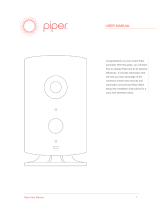
190-02763-00 Rev. A
Garmin G1000 NXi Pilot’s Guide for the Piper PA-46 Meridian
xi
TABLE OF CONTENTS
SECTION 1 SYSTEM OVERVIEW
1.1 System Description ..............................................1
1.2 System Controls ...................................................4
PFD Controls .......................................................................4
PFD/MFD Controller ............................................................6
Secure Digital (SD) Cards ....................................................8
1.3 System Operation ..............................................10
Applying Power to the System ..........................................10
Normal Operation .............................................................10
Reversionary Mode ...........................................................11
System Annunciations .......................................................12
System Status....................................................................14
AHRS Operation ................................................................15
GPS Receiver Operation ....................................................17
1.4 Accessing System Functionality .........................22
Softkey Function ...............................................................22
Menus ............................................................................... 26
MFD Page Groups .............................................................27
System Settings .................................................................30
System Utilities .................................................................38
1.5 Display Backlighting ..........................................43
SECTION 2 FLIGHT INSTRUMENTS
2.1 Flight Instruments ..............................................48
Airspeed Indicator ............................................................. 48
Attitude Indicator ..............................................................49
Altimeter ........................................................................... 50
Vertical Speed Indicator (VSI) ............................................ 54
Vertical Deviation Indicator (VDI) ...................................... 55
Vertical Navigation (VNV) Indications ...............................57
Horizontal Situation Indicator (HSI) ...................................58
Course Deviation Indicator (CDI) .......................................62
2.2 Supplemental Flight Data ..................................69
Temperature Displays ........................................................ 69
Wind Data ......................................................................... 69
2.3 Garmin Synthetic Vision Technology (SVT)
(Optional) ...................................................................71
SVT Operation ................................................................... 72
SVT Features .....................................................................73
Field of View .....................................................................83
2.4 PFD Annunciations and Alerting Functions ........84
Marker Beacon Annunciations ..........................................84
Altitude Alerting ................................................................84
Low Altitude Annunciation ................................................ 84
Minimum Altitude Alerting ................................................85
2.5 Abnormal Operations .........................................87
Abnormal GPS Conditions .................................................87
Comparator Annunciations ...............................................88
Reversionary Sensor Annunciations ..................................89
Garmin SVT Troubleshooting ............................................. 89
Garmin SVT In Reversionary Mode ....................................90
Unusual Attitudes .............................................................90
Garmin SVT Unusual Attitudes .......................................... 90
SECTION 3
ENGINE AND AIRFRAME SYSTEMS
3.1 EIS Display ............................................................94
Engine Exceedances .......................................................... 97
3.2
EIS Display (Reversionary Mode) .........................98
SECTION 4 AUDIO PANEL AND CNS
4.1 Overview ............................................................ 99
PFD Controls and Frequency Display ............................... 100
Audio Panel Controls ......................................................102
PFD/MFD Controller ........................................................106
4.2 COM Operation ................................................108
COM TUNING BOXES ......................................................108
COM Transceiver Manual Tuning ..................................... 109
Auto-Tuning the COM Frequency ....................................109
Frequency Spacing ..........................................................112
4.3 NAV Operation .................................................113
NAV Tuning Boxes ........................................................... 113
NAV Radio Selection and Activation................................114
NAV Receiver Manual Tuning .......................................... 114
Auto-Tuning a NAV Frequency from the MFD .................114
Marker Beacon Receiver .................................................117
DME Tuning .....................................................................118
4.4 Mode S Transponder ........................................119
Transponder Controls ......................................................119
Transponder Mode Selection ........................................... 120
Entering a Transponder Code ..........................................122
IDENT Function ...............................................................123
4.5 Additional Audio Panel Functions ....................124
Power Application ...........................................................124
Mono/Stereo Headsets .................................................... 124
Speaker ...........................................................................124
Intercom System (GMA 1347) ......................................... 124
Intercom System (GMA 1360D) ......................................125
Passenger Address (PA) System (GMA 1347) ..................127
Passenger Address (PA) System (GMA 1360D) ................ 128
Split-Com Mode ..............................................................128
Simultaneous COM Operation ........................................128
Clearance Recorder and Player .......................................128
Telephone and Entertainment Inputs (GMA 1347) .......... 129
Telephone and Entertainment Inputs (GMA 1360D) .......130
Bluetooth
.......................................................................131





















